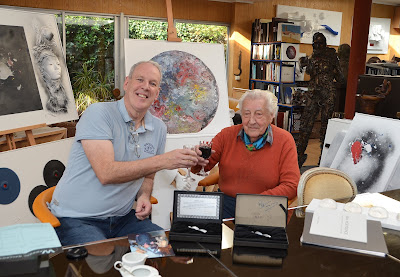In April 1972, during CBS Apollo 16 launch coverage, sculptor
Paul van Hoeydonck confirmed to Walter Cronkite that he was the artist
responsible for the memorial sculpture known as the ”Fallen Astronaut”.
Placed on the lunar surface nine months
previous, the crew of Apollo 15 had insisted that the name of the artist remain
a secret until the conclusion of the Apollo program the following year.
Following the revelation and in an attempt to boost the
fortunes of the struggling Waddell Gallery in New York, owner Dick Waddell… in
conjunction with van Hoeydonck, decided to offer a signed limited edition
series of 950 “Fallen Astronaut” replicas to collectors at $750 each… with the
intention of creating a second, cheaper series.
This was contrary to Apollo 15 Commander Dave Scott’s understanding
of his “gentleman’s agreement” with the artist - that there was to be no commercialisation of
the piece. That however was not Paul van Hoeydonck’s recollection and the planned production of the limited edition continued until the artist put an end to the project following pressure from the US State Dept.
Van Hoeydonck returned to Europe where 51 replicas were made, all of which the artist can account for.
Then in April 2015, a replica
purporting to be one of the limited edition was offered for sale on ebay.
Numbered 200/950 the figure was offered for sale by the grandson of the late
James T.Phillips Jr – a senior investment banker for J.P. Morgan based in New York
and a collector of space artefacts and works of art. Mr Phillips had the means,
the motive and the opportunity to make such a purchase.
Compelling evidence supporting its authenticity included
a receipt of purchase from the Waddell Gallery and an accompanying certificate
of authenticity signed by the artist Paul van Hoeydonck.
This find poses many questions not least how many of the planned replicas, if any were actually made and of those, how many
were sold? Sadly, gallery owner Dick Waddell passed away in 1974 aged
just 50. Depression, divorce and financial worries had taken their toll.
Perhaps Dick Waddell had sold some privately in an
attempt to alleviate his personal demons? Correspondence with the manufacturer
has drawn a blank. Neither Bruce Gitlin nor Milgo/Bufkin were willing to tell me anything about the project though I later learned that they are are contractually obliged to share information with the artist alone.
When questioned about the replica figure exhibited by
the National Air and Space Museum in Washington D.C, the museum confirmed … “Stamped into the back
of the head are the marks "c 1971." Marks that match all known
authorised replicas… and this ebay find.
When this eBay Fallen Astronaut find appeared in 2015, I
sent details including close up photos to the artist Paul van Hoeydonck. His
initial response was that the piece was fake. Not surprising really when one
considers the unauthorized duplicates and copies that have cropped up over the
years. But there must have been something about this item that
warranted further scrutiny as Paul and his partner then began an investigation
in to the piece.
Three years passed and following intensive research the artist
has come back to me (via his wife Marleen) with some very interesting news.
The figure is indeed an original.
“I’m happy to let you know that the replica you bought
seems to be an exact replica from the Fallen Astronaut…. but to be 100% certain
we would need to see the piece in person”
The box and the aluminium COA affixed inside the lid and
signed by Paul van Hoeydonck are authentic too. Produced by the Waddell Gallery
"The box and the certificate were meant to be for the multiples." A
note from Dick Waddell located in van Hoeydonck's archive indicates that he
wanted Paul to "sign the certificates starting with your number (200)". Why the number 200 is not known for certain but it is believed to have been for marketing purposes.
Van Hoeydonck also confirmed that the Waddell Gallery sold at least one of the figures.
"The gallery had already an order. They sold one of the models. So you
seem to have one of the models." So naturally I asked the artists if I could bring the figure to his
home in the outskirts of Antwerp in Belgium for verification and he graciously agreed.
van Hoeydonck told me that 5 of the figures encased in blue perspex were made and sent to Apollo 15 commander Dave Scott. All 5 were to be carried to the moon: one to be placed on the lunar surface and the others shared with the crew and the artist.
But concerns over weight and fire safety meant none could be flown.... so a late call was made for an alternate.
Records show that 4 or 5 "naked" prototypes were made (by the Milgo Bufkin Company) ahead of the mission one of which eventually made it to the lunar surface. It could so easily have been this piece!!
Marleen van Hoeydonck showed me the only known - complete piece intended for the limited edition of 950. Most likely to see what the finished article looked like ahead of full production. Numbered 624/950, this piece is in van Hoeydonck's possession.
I would like to thank Paul and Marleen van Hoeydonck for
the time, their kindness and generosity of spirit for which I will be forever
grateful.
In the summer of 2021 I had the opportunity to show the sculpture on The Antiques Roadshow recorded at Aston Hall, Birmingham. After contacting the BBC to share the story, the producers were very keen to feature the sculpture. It was evident both before and during the recording that the expert Paul Atterbury had clearly done his homework ahead of the encounter and was excited to see the item


_-_edited.jpg)















.jpg)

















